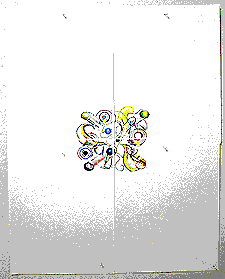View current page
42 matchs for infinite:
Missed the Tarantino/Rodriguez double feature Grindhouse, which did so-so box office and now will be split into two films for non-U.S. distribution. The Tarantino segment "Death-Proof" has been selected for Cannes; Robert Rodriguez's "Planet Terror" hasn't been. Salon (prob. subscription-only, sorry) reports on the "Death-Proof" press conference below. The producers have "restored" the film (or padded it out with cut footage, depending on how you see it) and are releasing it in France as "Boulevard de la mort."
Most strange and striking of all was the moment when [producer Harvey] Weinstein moved in to squelch all further discussion of "Grindhouse," and in the process seemed to deliver a slap-down to Kurt Russell. Most of the participants stayed on message most of the time, meaning that Tarantino insisted that the longer, "Boulevard of Death" version of the film is closer to his original intentions. Russell, who plays impressively evil Stuntman Mike, wasn't having it. "I'm sorry for people who won't get the 'Grindhouse' experience," he said. "That's what it was all about for me. So I prefer the shorter version. Now ['Death Proof' and 'Terror Planet'] are gonna go off and stand on their own, and hopefully you'll enjoy them. But in 20 years, you will want the full 'Grindhouse' experience, because there's nothing else like it."Update: Grindhouse is still playing in the theatre in NY (in Times Square of all places) so I checked it out this afternoon. The Tarantino burned brightly and intelligently (though 'twasn't enough premise for a full length, sorry, France), while Rodriguez's "Planet Terror" paid your standard loving tribute to zombie movies, with an increased disgusting gore quotient. Special effects man Tom Savini plays a small acting role in "PT"; his exploding body prosthetics ruined many an '80s film and Rodriguez has aped them and upped them in the present glopfest. Neither "Death-Proof" nor "PT" particularly evoked '70s grindhouse, aside from the scratched and grainy film stock. Tarantino's bit is a sui generis art movie--Hollywood/gender deconstruction via the theme of "muscle cars and the pros who drive them and go psycho"--and the Rodriguez mostly a subtextless homage to '80s slasher films, a genre still chugging along as late as the '90s (Tales of the Crypt: Demon Knight) and the '00s (the Scream franchise). 2002's Cabin Fever (directed by Eli Roth, who also has a bit part in "Death-Proof"), seemed more authentically '70s to me. In any case, everything about the Rodriguez felt familiar. The gore in the Tarantino happens quickly, doesn't linger, and disturbs infinitely more.
Weinstein held his peace at that moment, but a few minutes later, when another eastern European journalist asked why none of the fake trailers from "Grindhouse" are being shown with "Death Proof," he stepped up to the mike. "We had a great time with the whole 'Grindhouse' thing," he began, in the tones of a man not having any fun at all. "Now European audiences will get to see these new movies by Quentin Tarantino and Robert Rodriguez, and they'll enjoy them much more [than 'Grindhouse']. You'll see Robert Rodriguez making a true Robert Rodriguez movie, you'll see Quentin making a pure-essence Quentin movie. It's a completely different experience. They will dwarf 'Grindhouse,' trust me."
If you happen to be in Scotland tomorrow, please check out the show below. My animated GIFs will be projected 22 times in a line of screens running down a long wall. Earlier I posted a prototype showing how it would work with 4 screens (Double Centrifuge GIF x 4, test of multiple versions: [65 KB Quicktime .mov]).
Fresh NY
Alisa Andrasek, Michael Bell-Smith, Brody Condon, Brent Green, Tom Moody, Takeshi Murata, and Prema Murthy
guest curated by Anne Barlow
New York comes to Perth on Saturday, 3 February 2007. The meeting point is Threshold artspace, the contemporary art gallery at the threshold of Perth Concert Hall. The occasion is Fresh NY--an exhibition which showcases seven of the most exciting young artists working with animation and digital media in the New York region--most of whose work is being seen in Scotland and the UK for the first time. Fresh NY's guest curator is Anne Barlow, a Scot based in New York, previously at the New Museum of Contemporary Art and just appointed Executive Director of Art in General – one of New York's leading not-for profit arts organisations.
"Reflecting current tendencies in contemporary digital art," states Barlow, "Fresh NY includes an intriguing mix of projects, from beautifully crafted animations to hypnotic, computer-generated visuals, and work inspired by gaming culture”.
The public preview of Fresh NY also compliments Bang on a Can--New York's electric chamber ensemble who performs in the concert hall throughout the day including music by Stephen Reich, Philip Glass and Brian Eno. After the all day long public preview, the works featured in Fresh NY will become part of the Threshold artspace collection and shown regularly as part of the daily programmes.
More about the works in Fresh NY
Brent Green, a self-taught animated filmmaker, presents Hadacol Christmas, a strange and haunting story about Mr. Claus who is addicted to Hadacol cough syrup. While aspects of Green’s work conjure up early Walt Disney drawings, the dark animations of Tim Burton, or Appalachian folk-tales, this short film remains a highly personal production.
Together with Green, the artists Tom Moody and Michael Bell-Smith share a love of the 'lo-fi”, but their influences come more from their immediate 'graphic landscape' of mobile phone visual displays, urban media screens, and web page advertisements.
Tom Moody proudly creates low-tech art with standard off-the-shelf products such as simple paint programmes, photocopiers and consumer printers. The Threshold Wave goes franticly busy with Moody's tiny animated GIFs now scaled up to optical art proportions. Moody belongs to a current generation of artists, who use those twinkling and often irritating image files that draw your attention on a web page, known as GIFs, in playful or ironic ways.
Michael Bell-Smith also operates in the gap between 'smooth' or low-tech aesthetics; animated cartoons and painting with unusual effectiveness Much of his work is created by sampling and manipulating images from the Internet. As part of Fresh NY he presents Some Houses Have Pools – a dreamlike aerial view of an endless suburbia, devoid of any specific narrative. Bell-Smith's main concern is color, space and light, tweaked and amplified by digital technology and restrained animation.
Alisa Andrasek's work The Invisibles makes its debut on an extra large scale at the Threshold Wave of 22 screens. It consists of swirling and mesmeric 3D cells scripted in animation software. Andrasek, who principally works in the field of architecture, is interested in creating what she calls a “pattern intelligence” – which can be applied to surfaces and forms in architecture, design, and fashion.
Takeshi Murata pushes the boundaries of animation and psychedelia with sophisticated code-based image processing. Recreated as a hypnotic 22 screen installation Monster Movie is one of his most celebrated video work. Its lead character is a B-movie Yeti who decomposes and reconstitutes thirty times per second, becoming a seething, digital morass of color and form. “Murata’s particular genius is an almost alchemical ability to transform forgotten relics of pop culture into dazzling jewels” comments the American art journal Artforum.
Brody Condon's widely acclaimed work Karma Physics < Elvis is a tongue-in cheek, self-playing version of the popular computer game Unreal 2003. As the viewer's camera floats through an infinite pink afterlife, multiples of Elvis are controlled by 'Karma Physics' – the original game's engine used to simulate realistic game character death. Condon's work represents a highlight in the art games series showing on the Threshold Stage all year round.
Prema Murthy uses numerical information and video as a sculpting tool. As part of Fresh NY the artist presents an especially re-worked short film starring some of her strange creatures. The bodies integrate and disintegrate according to their fluctuating data values. Murthy's tool is a 3D modelling software programme and her skills involve sifting through tons of digital data such as immigration patterns, effects of global warming, and consumer spending.

Infinite Smile (view in Quicktime here), by the artist duo MTAA (M.River & T.Whid Art Associates), made its gallery debut last night in an elegantly appointed group show at Bryce Wolkowitz. A video of the artists holding smiles for a stretch of several agonizing minutes is sped up, then run forwards and backwards to make a continuous loop. The gallery projection is large and seamless and the viewer is transfixed helplessly before this techno-tableau of painful good intentions. The time-alterations give the subjects a twitchy, amphetamine-addled look: they might to be holding poses for some future dystopian hologram ID gone all glitchy due to budget cuts in the security ministry.
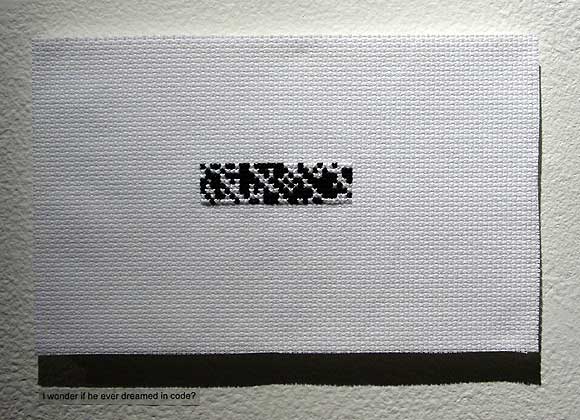
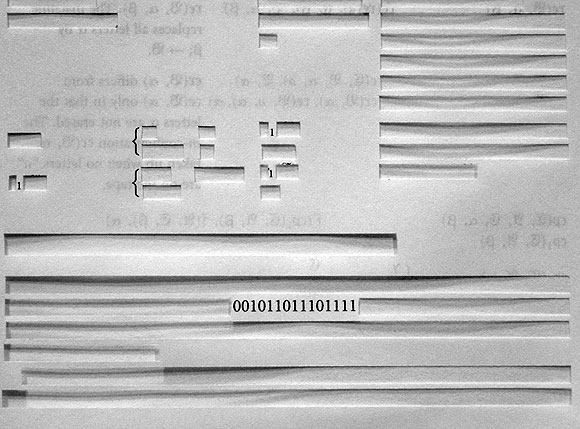
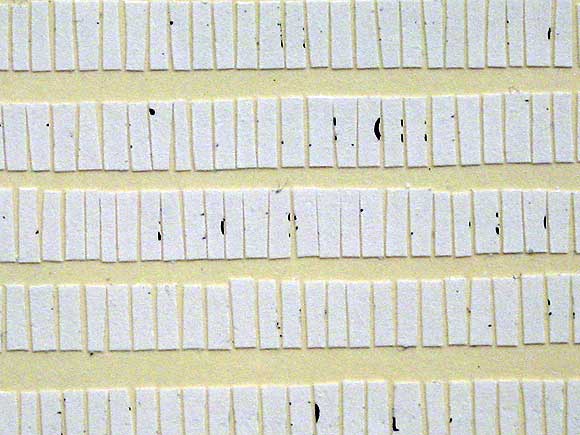
Some photos I took at Cody Trepte's show (for Alan Turing), at NYU/Tisch School of the Arts' Gulf & Western Gallery, 721 Broadway. More about the show is here. At the top is a "binary cross stitch" similar to the one Trepte had in the Infinite Fill Show a while back. The middle image is an essay by pioneering computer scientist and codebreaker Turing with everything but the 1s and 0s removed (detail of a 33 page installation). The bottom image, another detail, is the negative space (spaces between words) in another Turing essay. The show is a non-standard take on "computer art" in the gallery context. The formal vocabulary is reductive (or accumulative) minimalism a la Yayoi Kusama's airmail stamp paintings, and while the subject matter is the language of both the computer and the computer scientist, it's treated not in a literal way but rather as an absence, or anti-content. As the press release explains, Turing was gay and accused in the not so swinging '50s of "acts of gross indecency." His "sentence" was an "experimental hormone therapy" consisting of estrogen injections to "reduce the libido." He died a couple of years later, apparently a suicide, but with questions lingering. Trepte's work is thus not the typical Buzz Lightyear computer-fetish celebration but rather an examination of the repressed, fragile, elegiac back story to the "machine that's changed our lives."
The exhibition's up through Saturday, Jan. 6. Gallery hours are 10am through 7pm weekdays, and noon to 5pm on Saturdays.
In August I did a post about the interesting cross-disciplinary issues that come up when critical-minded folks from the club music scene describe academic electronic music with their own carefully honed vocabularies and sensibilities. Another good example comes, of course, from electronic dance/post-punk specialist Simon Reynolds, in this respectfully irreverent paragraph I just found on his blog:
Along with its relative affordability, one of the things I like about the second-division electronic avant-classical is its generic-ness. I mean that most sincerely folks. There's two facets to this 1/ if it’s a genre you love (say, ardkore, or freakbeat/garage punk, or dub, or whatever) then the genre-icity is no problemo, in fact the more fiercely it is itself, rather than dabbling outside its own parameters, than the better really; plus you have such an appetite for the stuff in question that you crave the second or even third-division material. But also 2/ there's this extra element of pathos and even a tiny hint of comedy too. See, here’s these guys who thought they were opening up infinite vistas and spectra of sound, boldly going where no composer's gone, building the future, etc. Yet a lot of it does tend to sound a bit samey. Partly because they only had a few different instruments at this point to grapple with: the Buchla, the Moog, a few other machines. But also beca[us]e a certain lexicon of sounds and FX got established that people tended to go for. In fact if I have some time at some point I’d like to do a taxonomy of those 12 or 16 or 23 noises/devices/effects, 'cos they do tend to crop up rather frequently. The other reason the avant-electronic stuff can sound generic is that the composers tended to use the machines as tools for extending their pre-electronic ideas, rather than search for the absolute idiomatic thing the machine could do. So there’s a lot of post-serialist approaches being transposed to synthesiser, I reckon. Which is why you get that feeling of clutter and twitter, flurries of note-runs and clusters, a fidgety fraugh[t]ness. There's also that atmosphere of disquiet that's very post-War existen[t]ialist-modernist-neurotic, kinda highly-strung and almost hands-wringingly anguished at times. But I suppose this makes perfect sense, was inevitable: composers who studied theory and went through conservatory training and all that, who have followed the grand narrative of western musical thought all the way through to the present juncture, or their own personal version of that arc/dialectic/whatever--they're not going to suddenly junk all their ideas and concepts and nous and technique, and just lay themselves open to the potentialities of the machinery, in a state of mind-voided open-ness and zero preconceptions. They’re going to dictate to the technology rather than the other way round. But that explains why a lot of the avant-electronic music sounds like 20th Century classical, as opposed to utterly alien and foreign, which you get more with your rock people perhaps, who lack the composerly grounding and also have more of a cheap thrills/gimmicky slanted approach to new tech.
My pieces Vortex 1 and Vortex 2, the title card information for which I posted here, will be in a show opening Friday night, September 8, in Mobile, AL. Here's the Press-Register article about the exhibit:
High concept : Space 301 opens high-tech multimedia show Friday
Sunday, September 03, 2006
By THOMAS B. HARRISON
Arts Editor
Our bold new millennium has brought a sense of impermanence at once terrifying and exhilarating.
New technologies make it possible for artists, writers and musicians to exist in a parallel universe, one foot in the corporeal (physical) world, the other in cyberspace. Sometimes simultaneously.
Hard to imagine a visual arts event with greater contemporary resonance than "Art and Place I: Place as Muse," which opens Friday and runs through Oct. 29 at Space 301 in downtown Mobile.
"This show is innovative on so many levels," says Barclay McConnell, curator for Space 301. "I think it will be very exciting, especially for anyone interested in the (seemingly infinite) creative possibilities of digital technologies and the World Wide Web.
"There will be video-game art and art films including a stop-animation DVD of an artist's homepage as it evolved over several years. [preview .mov from Paul Slocum here]
"Contemporary artists are really pushing the boundaries in terms of medium -- moving away from the traditional such as drawing and painting into using video, computers and the Web in new and unusual ways."
McConnell says "Art and Place" is "full of new media" and has a fascinating concept. This show also marks the debut of guest curator Clayton V. Colvin, creator of the StealthArts Web site and an adjunct instructor at the University of Alabama and UAB in Birmingham.
Based in Birmingham, StealthArts is an "evolving space focused on contemporary art," according to the Web site: www.stealtharts.com. Viewing is by appointment.
"Clayton is a respected and very intelligent young curator bringing something entirely new to Mobile," says McConnell.
In his curatorial statement, Colvin writes:
"As a culture, our concept of place is in flux. We can mean a physical location, a virtual location on the World Wide Web, or a fictional location in a narrative or fantasy. Regardless, we are talking about an environment; a space."
Colvin hopes this exhibition will explore how artists are creating works using place as subject or muse.
"The relationship of individual to location is interestingly entangled with personal experience and identity," he writes.
"A person's relationship to the land can define their character. Its presence may be subconscious, surfacing in quiet thoughts of nostalgia for the pastoral, or in loud symbols of hysterical nationalism.
"It is difficult to imagine an identity without a place, be that a destination in the future, a place of the present, or point of origin."
Colvin selected 20 artists to investigate "how (or if) this relationship changes as the concept of place becomes a synthesis of the virtual and the concrete."
The artists examine the issue by exploring telecommunications and the Internet, globalization, homelessness, journalism, personal memory, hallucination, tourism, genocide, natural disasters and video games, according to Colvin.
Colvin says he is keenly interested in artists who deal with topical issues in both an old-school way through painting and sculpture, as well as artists whose work exists primarily in MySpace pages and jpeg files.
"You have online friends and then real-life friends also," he says. Colvin says he met many of these artists in the 1990s, a convenient point of reference for anyone trying to make sense of the ever-changing concept of "place." Net-art came of age in the '90s and is now being revisited, he says.
He says the diverse range of artwork here is "very contemporary with what artists are doing right now," but as one would expect, it is not a regional exhibition. Some of the artists live and work in the South; others are from New York City, Los Angeles, Texas, Nebraska. One lives in London.
That's a worldwide web of artwork.
Memphis artist Hamlett Dobbins takes a traditional approach by capturing a moment in time, says Colvin. His oil-on-linen panels are titled with the initials of the person with whom he shared those moments, "so for him it's about personal memory."
Paul Slocum of Dallas contributed a stop-animation of his homepage; New York artist Tom Moody's "Vortex 1" was created from inkjet on paper.
Birmingham photographer Ryan Russell (ryanrussell.net), who graduated from UAB in graphic design, shoots photos of rock bands and travels a lot, and his work reflects a life in transit.
His "Photograph From a Delta Airplane" provides the postcard image for the exhibition.
One of the more intriguing artists in the show is Jason Varone (www.varonearts.org) of Brooklyn, N.Y., who attended NYU with Colvin and whose work focuses on telecommunications. "Topology of Technology" is a mixed-media DVD.
Colvin hopes visitors to Space 301 will have a chance to experience these varying perspectives and walk away with new ideas and insights.
"Hopefully it'll strengthen whatever relationship (the viewers) already have to place," he says.
Thanks to Eyebeam and Rhizome.org* for reblogging the recent post here on Paul Lansky. That writing's been revised a bit, including fixing one unfortunate flub: the phrase "now a kind of parallel universe to the academic camp" in the second paragraph was missing the "the," which made it sound like the post was calling "music department music" camp or kitsch. Some of it is, but not Lansky's. Some more late thoughts on Lansky's essay "The Importance of Being Digital" follow.
A possible contradiction in the essay: Lansky describes in great detail how analog recording errors can mar the pristine perfection of a digital music composition (such errors are called "artifacts," whether analog or digital). He recounts anecdotally, from the bad old days, all the steps involved in transferring a computer music piece of his to vinyl, each of which introduced artifacts. One of his philosophical selling points for digital technology is its ability to make an artifact-free copy, which is then nearly infinitely reproducible on a mass consumption level. (An aside: Lansky's irritability over intrusive sounds explains much about his music, which is remarkably smooth even at its most boisterous.)
Yet while praising the perfect copy Lansky argues for digital music's ability to exploit the "loudspeaker as instrument." In other words, the speaker is not just a window through which a pre-existing sound reality passes. Woofers and tweeters (and the creators who control them) can actively shape and define their own sonic reality. But if that is the case, why is purity of signal such a virtue? Does clarity even exist if no comparison is to be made to a pre-existing sound?
Lansky describes how analog copying procedures carry with them their own history. A grainy xerox of a smudged newspaper image of a black and white photo, for example, tells a story as much as the underlying picture. Setting aside the fact that digital production has its own artifacts, such as the non-stop yodeling of a skipping CD: this "history" can be just as much a part of that "loudspeaker reality" Lansky champions. In other words, it can serve as content to be actively used by the composer, whether through the deliberate introduction of skips and errors into the recording process, or by adding a patina of age or "period" to music, as in the distinctive mellow hum of an old tube amp: a mix of fact and fiction to be sorted out by the listener.
The point of all this being not to challenge Lansky's core arguments but simply to demote "purity of signal" in the pantheon of digital music's virtues, significantly below "ease of copying," manipulatability, and "ability to define its own reality." If clarity has a virtue at all, it is, as Lansky suggests, that it allows infinite cutting and pasting in the composition process without changing the sound in undesired ways due to accumulating artifacts. Being able to create a "richer," "fuller" sound from the rich pallette of prior recorded or previously unrecorded sounds allows the composer to more accurately trigger associations in the listener while at the same time plugging this data into the composition's imaginary patchbay of abstraction and representation.
*Update, 2011: Eyebeam reblog archives are dead. The Rhizome link has been changed to http://rhizome.org/editorial/2006/aug/12/p-lansky-club-vs-academic-electronic-music/. Please note that I authored the post, not Marisa Olson.
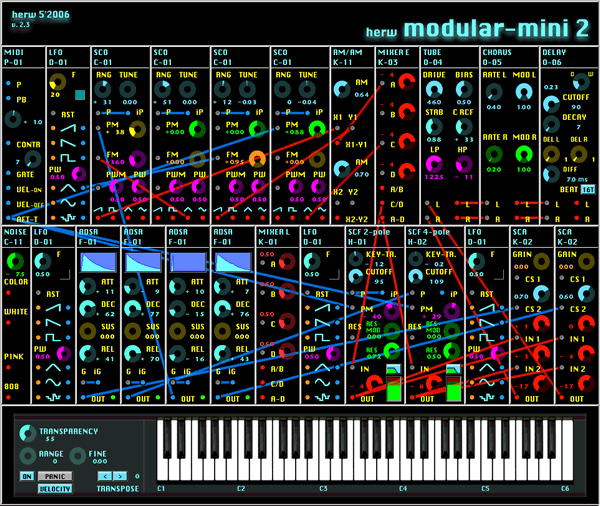
New compositions on the Reaktions site, all made with versions of the HERW Modular-Mini synth--a user-built instrument in the Reaktor library. While all Reaktor synths are "modular" and "patchable" in the sense that you can go behind the interface and move parts and wires around, this one has virtual patchcords (and a keyboard) on the front. The look and sound recalls the old modular synths from the '60s and '70s, so not surprisingly the compilation has its nods to Wendy Carlos, Keith Emerson, and the Forbidden Planet score, all updated into the clean, infinitely tweakable digital environment. My favorite .mp3s are by chietronix, r.domain, Joe Risch, and herw (Herwig Krass) himself. The Reaktions group is a bit insular--many restrictions are put on the entries for these compilations, the main one being "made in Reaktor only." I suppose it's a way to really learn the instrument, but it's like Iron Chef having a "soft shell crab battle" where the only ingredient the chefs could use was soft shelled crab. Yes, one is a foodstuff and the other is a totalizing instrument, but while all-Reaktor compositions can be stimulating they frequently need something else.
An earlier report, on the Oki Computer 2 compilation, is here.
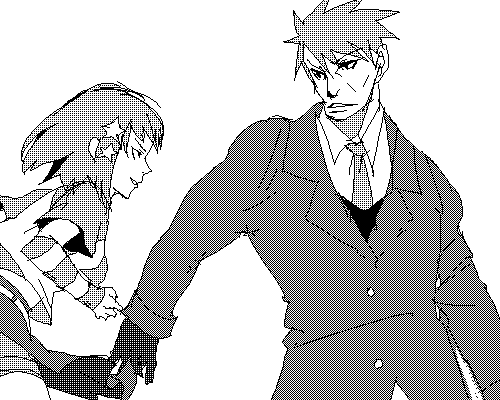
dude gets whupped - artist unknown
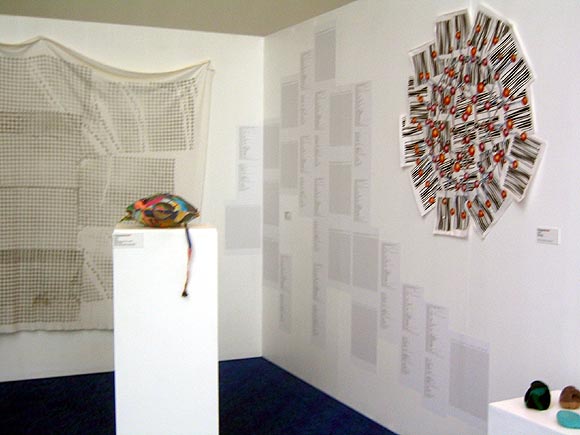
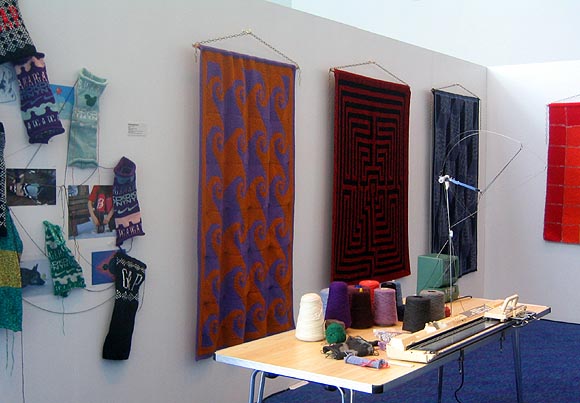
Finally got some pics of the "Fuzzy Logic" show from summer 2005, in Manchester, UK, curated by Jackie Passmore and Michael Connor. A million thanks to Cat Mazza for these photos. The show was discussed a bit here (scroll way down). The top photo depicts Cory Arcangel's Infinite Fill Blanket, Peter Coffin's "wall-based prints bridging ASCII art and knitting patterns," a LoVid soft sound sculpture on the pedestal, my Fuzzyball paper piece upper right, and Claire Irving's mathematical knitting in the foreground. The bottom photo shows Cat Mazza's logoknit pieces and her knitting machine, and Woolly Thoughts' Mathematical Afghans.
current blog page / main site
Thanks to Robert Huffman at the Modern Theory & Contemporary Criticism forum on Myspace for his photo- and gif-annotated version of the Rhizome.org interview [dead link--see below] Cory Arcangel did with me. Robert also reBlogged the item on his blog SPACEprogram. A couple of late corrections to the interview:
Digital Media Tree is the brainchild of Jim Bassett, who wrote the software and has been the low-key, creative, officially-unofficial webmaster sinceI said 2000 in the interview; I knew that Jim, drat fink, and some other Tree-ers started blogging earlier (in the first Blogger era) but couldn't find any '99 posts until Alex Wilson reminded me that his Arboretum, covering his travels in the Central Park outback (among many other things), started in December of that year. Another minor bug in the interview was this paragraph:20001999. It is a blog collective and quite active, with all of us commenting on each other's pages and posting to public and private group pages. My invitation to join the group came from artist Bill Schwarz, who has a page at www.digitalmediatree.com/schwarz/. There are features at the Tree at I haven't found in other blog packages, such as the ease of configuring pages with "use your own html" options, and the ability to spin off an infinite series of customized pages, as blogs or fixed pages. I'm too lazy to learn CSS, but actually prefer my page's under-designed html look.
In my college DJ years I was airing Can, Ralf and Florian, Tony Williams Lifetime, Iggy Pop's The Idiot, etc. My jaw dropped, in the early '90s, when I first heard [that] breakbeat 'ardkore rave stuff. I couldn't believe how good it was--it was like all my influences grew up (and sped up).I left out the "that."
Update: New Link to Cory's interview with me.
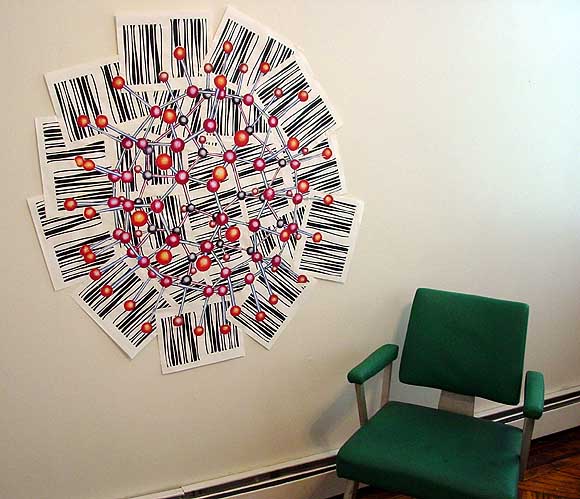
The above piece, Fuzzyball, has been shipped over to Manchester, UK, for the Futuresonic festival. It's in an exhibit called "Fuzzy Logic," which is a subset of another exhibition called "Low Grade" that is part of the larger festival. The curators are Jackie Passmore and Michael Connor. By the way, the molecule above really is called a "fuzzyball" (a buckyball variant); I didn't title it just for the show. Here's the rundown on "Fuzzy Logic":
"Low Grade" argues that the roots of computing technology are linked to Britain's 19th Century cotton trade, with weaving looms providing inspiration for the design of the first computer. In a city famous for both its textile history - Manchester was once known as "Cottonopolis" - and as the birthplace of the modern computer, "Fuzzy Logic" demonstrates how new media artists are turning back to the loom, combining technology with the knitting needle to create a new wave of fabric-based media arts, mathematical knitting and textile activism.My piece doesn't involve knitting but I have always described this type of work as a paper quilt or mosaic. When I started doing these pieces in the mid-90s I was very interested in cyberfeminist Sadie Plant, who is speaking at the festival, and I was somewhat chagrined to discover no one in the NY art world was following this dialogue, or giving any particular thought to bridging the computational and the crafted. Things have gotten better in the last few years with the arrival on the scene of many of the above artists, so I'm not feeling quite as lonely as I did in 1997, when the gallery I was showing with mostly just apologized for the work, as in "Sorry it's not made with a brush or pencil and fabricated of fine, durable art materials, we know how important that is to you, Mrs. Drysdale." As late as 2001, a dealer I was working with was still asking me questions like "Do you ever think of painting these?"
Artists and works include:
Claire Irving (UK): Mathematical Knitting
Woolly Thoughts (UK): Mathematical Afghans
Cat Mazza (US): KnitPro Software, the LogoKnit knitting machine and examples of knitted work
Mandy McIntosh (UK): Knitting patterns for Atlanta and other cities, plus Radiant Circle
LoVid (US): Soft sound sculpture, sculpting psychedelic soundsssssssssssz
Peter Coffin (US): Wall-based prints bridging ASCII art and knitting patterns
Cory Arcangel (US): Security blanket based on the "infinite fill" patterns used in place of colour on early drawing software Mac Paint
Rebecca Vaughan (US): Conceptual knitted cosies for uncosy environments
Tom Moody (US): Psychedelic and abject works riding the guardrails between the handmade and the digital
Chris Ashley, The Infinite Line: List, 2005, HTML, 620 x 500 pixels
Blogging and the Arts Panel 2
Rhizome.org at the New Museum is having its second Blogging and the Arts Panel tomorrow night, Tuesday, May 17. You may recall the first panel, which yours truly was on and which got written up ad infinitum...on this page. Here's the prospectus for tomorrow's:
Rhizome.org Director of Technology Francis Hwang will lead a panel discussion on Blogging and the Arts. This panel, the second in a series hosted by Rhizome.org, includes painter and web-artist Chris Ashley, painter Joy Garnett, artist and programmer Patrick May, and writer Liza Sabater. The discussion will address issues such as ways that artists are using blogs to distribute their own work, and the influence of blogging culture on political issues of interest to those in the arts.Chris Ashley's work has been talked about on this weblog quite a bit; it's nice to see him getting over here to the east coast for some meat space confabbing. His work was described by some internet soundbite-meister as "Mondrian for your browser," and that's perfectly good but omits a few art historical steps and much of the innovation, as described here and here.
About Rhizome.org
Founded in 1996, Rhizome.org is an internet-based platform for the global new media arts community. Through programs such as publications, online discussion, art commissions, and archiving, it supports the creation, presentation, discussion, and preservation of contemporary art using new technologies. Since 2003, Rhizome.org has been affiliated with the New Museum of Contemporary Art.
Details from Michael Bell-Smith's video, Top of the World, at Foxy Production, in the group exhibition "GEO," which runs through February 8, 2005.

The video begins with an aerial perspective looking down on a videogame landscape (sort of reminiscent of the old Intellivision tank battle terrain, but it could be a lot of things from that era). Directional arrows invade the middle ground and...
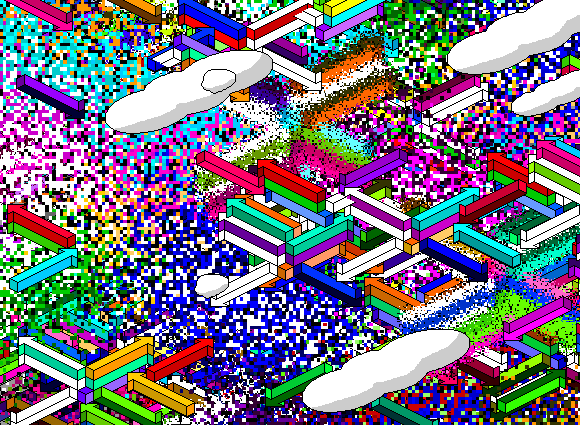
...after passing over, under, and around each other they begin to dissolve into painterly sprays of pure pixelation--a gorgeous effect, but not too gorgeous. It looks like a specific set of commands to "break down" as opposed to a one-click Photoshop filter; don't know if any, or how much, custom programming was required and don't care particularly. Eventually the screen fills with a succulent allover abstraction that could be Monet's Water Lilies a la Bit-Rot.
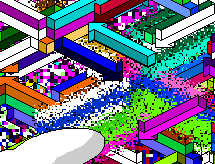
This detail showing the initial breakdown into pixels probably looks fuzzy in Safari--another browser is recommended to see this scaled up image super-sharp.
In the gallery, the video is displayed on an LCD screen directly from the computer. My only quibble is I miss seeing this type of imagery on the big clunky CRT picture tube, as a similar work of Bell-Smith's was displayed last summer in the Infinite Fill Group Show. Ideally when he has a solo exhibit we can see his work with a variety of formats and hardware. Also recommended is a music piece on Bell-Smith's blog that is a kind of marathon sequencer ditty--curious to see what happens with that if it reaches the projected 74 minutes.
TOM MOODY WEBLOG TOP TEN 2004
1. Site Specific Art is Dead; Long Live.... According to this text from the year 2035, the dinosaur finally died when artists ran amok in the Saarinen airport terminal; meanwhile, the small mammals of wireless and GPS-based art stirred at Spectropolis 2004 and the psy.geo.CONFLUX.
2. Diana Kingsley at Leo Castelli. This artist's subtle humor has been evading the New York art world for years. The New Yorker is the latest not to get it.
3. Ross Knight at the Sculpture Center. More art too subtle for Saltz and the pros.
4. The Infinite Fill Show at Foxy Production. Disclosure: yrs truly was in this show (along with 92 other artists).
5. Four-way tie: Banks Violette at Team, John Parker at Front Room, Joe McKay at vertexList, Paper Rad at Foxy Production (and online).
6. Loretta Lux. Powerful images of ideal children combine painting, photography and digi-manipulation, made even more meme-worthy by resizing at a web-friendly 300 x 300 pixels.
7. Chris Ashley, Jan - December 2004. Abstract painter moves to web, uses your browser to make paintings, blows away competition.
8. SCREENFULL, July - December 2004. If Sigmar Polke were in his 20s today and/or Richard Prince surfed the net instead of painting, this is what they'd be doing. If only it could be commodified...
9. Michelle Handelman in Bryant Park. The performances were memorably quirky, the summer day was beautiful, Bryant Park was beautiful...
10. Duncan Hannah at JG Contemporary/James Graham & Sons. Weirdly affectless Hopperesque work by one of New York's best painters, whose work has long been too subtle for...oh never mind.
Honorable Mention: The art world's efforts to end the Iraq War and throw the current bums out of office, even though both have so far failed.
Another map, this one via thickeye:

In the comments, Cinque H continues to call for temperate language towards the Bushvoters. He's living out there among them, so maybe it's like, don't say Big Smelly Cat when you're in a cage full of lions. I understand all that about being noble and not sinking to the level of right wing hate rhetoric, but I disagree with the analogy of the Bushvoters defending themselves being like us having to defend Clinton after Waco (and other bad things that happened from '92-'99). Barbecuing 80 Americans for their religious practices was awful, but Iraq is infinitely worse--it's simply not defensible on any level except "me dumb me see Saddam on teevee he bad man." Assuming the 59 million people aren't out and out mentally handicapped, they are morally culpable for the killing in Bush's vendetta. I'm not interested in winning them over, I'd rather see them disappear through attrition and old age (see previous post re: demographics) and keep working on the ones who didn't vote, making intellectual freedom seem fun and sexy. Also, you can't reason with the wingnuts, we have one that keeps popping up on this site repeating the same tired phrases no matter how sensitive and rational people try to be.
In a comment to the previous post, Brent questions whether Chris Ashley's stationary HTML drawing and jimpunk's moving .GIF are comparable or compatible on the same page. My usual quip about showing video next to paintings in a gallery setting is that it's like bringing a baby to a wedding, but the browser is the great equalizer. A few more line breaks were added to the post so the pieces aren't quite so close together, but otherwise, yeah, I think they have more in common than not as art non-objects. Although neither artist is an Op artist in the old '60s sense, the pieces exploit optical tricks over and above their plain formal appeal: illusory depth in the Ashley and quite literal vibration in the jp. Moreover, they are fresh takes on the grid and opticality, which the New York Times and the Village Voice love to dismiss as the concerns of a bygone generation, in spite of all evidence to the contrary (e.g., the Infinite Fill show.)
The "Infinite Fill Show" is now officially down, and the gallery, Foxy Production, suggested a way to pull up the somewhat obsessive posting on the subject here, which I hadn't thought of (duh): just click http://www.digitalmediatree.com/tommoody/?search=infinite+fill. That brings up 20 posts, including this one. Comments aren't included in the search, so you have to click on those separately. If you click http://www.digitalmediatree.com/tommoody/?search=infinite, you get 7 extra off-topic (but really good!) posts.
By the way, for anyone who wants to cite this page in a bio, press release or angry spam email, "Tom Moody" is preferred, or secondarily, "Tom Moody's Weblog." While "Digital Media Tree" sometimes appears as a cite for this log, that's not really correct; the Tree is a weblog collective and each of us has our own independent, wholly unedited content.
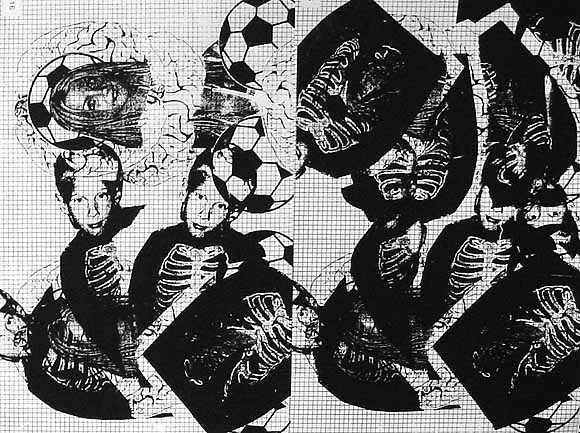
Ryan Compton, Mathematics of Composition (Brains and Grid), silkscreen, 2004, 17.5 X 22.5 inches, from "The Infinite Fill Show." "Compton invests what Leo Steinberg called the 'flatbed picture plane' of Rauschenberg and Warhol with the almost perceptible audial tint of a feeding-back electric guitar dropped from a considerable height." --October magazine (just kidding, I made that up). I believe that's Britney Spears posed like the Virgin Mary over the soccer ball and the brains.
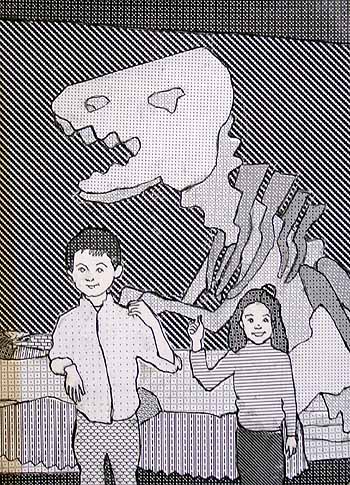 |
|
UPDATE: A large-ish image (750 x 1000) of Joe McKay's piece has been added and linked to in the post where it's discussed.
 To the left is Time Out NY's "Infinite Fill Show" review; on the whole it's better than the NY Times'. Below is the accompanying photo. My notes on the review: To the left is Time Out NY's "Infinite Fill Show" review; on the whole it's better than the NY Times'. Below is the accompanying photo. My notes on the review:At least this writer got Jamie Arcangel's sex right, but it's Foxy Production, singular. "[F]ew of the artworks reveal the influence of the computer age..." This is to calm regular readers of the Time Out art page, who might be freaked out by too much computer art in a gallery. "Several of the artists display Op Art grids made from media as disparate as a latch hook and cassette tapes, including a vinyl piece by the curators' mother." That is how that sentence should read: I suspect editorial garbling in the published text. Props to Joe McKay for undulations catching the critic's eye. His piece is good, a sort of moving Suprematist abstraction gliding in and out of a permanent dark band on a broken PowerBook. Broken consumer tech=very good. [J]ust as computers generate complexity using a binary system of 1s and 0s, the Arcangels' two simple criteria [black & white + repeating patterns] have yielded a superabundance of pattern--not to mention artwork..." Yes! Bemoaners of the "crisis of criticism," you get your theory where you find it in the art world; this is a variant of Sally McKay's here on this blog (scroll down to comments). Roberta Smith only got the second half of this thought. |
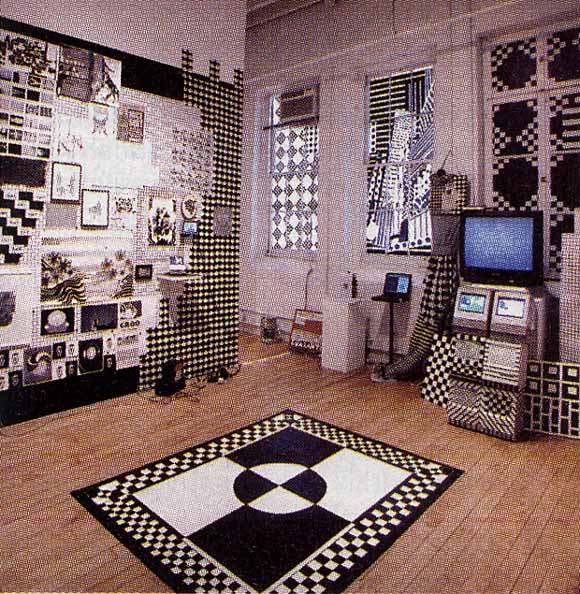 |
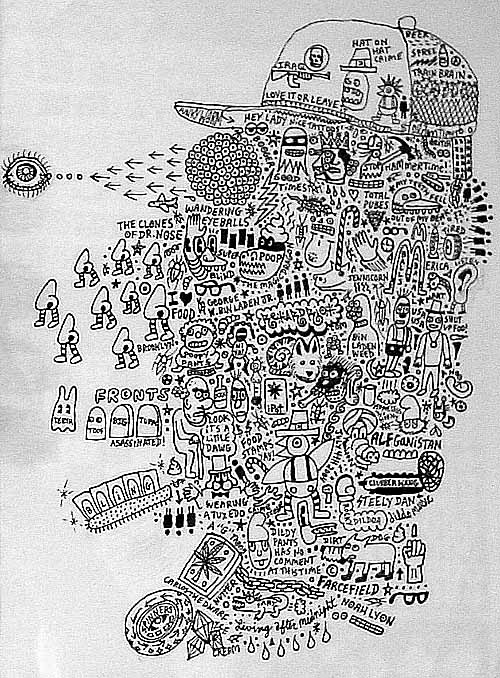
Two by Noah Lyon, from "The Infinite Fill Show." Above: "Paper Rodeo Head," ink and whiteout on Bristol, 2004; below: "12 Eyes," mixed media, 2004. Paper Rodeo is a Providence zine crammed with imagery such as Lyon's cartoon homage to Arcimboldo. (The grey smears to the left are shadows from the buttons, which are adjacent to the drawing in the show.) The explosion of psychotropic-influenced graphics coming out of Providence is duly noted; still waiting for a critic to stop complaining about the state of criticism and get down to the hard work of defining how this particular graphic revolution differs from the Zap comix '60s and the Raw magazine '80s (it does differ). These days my taste leans more towards the cartoon minimalism of the "eye buttons," though it's so damn easy to provoke a response with eyes.
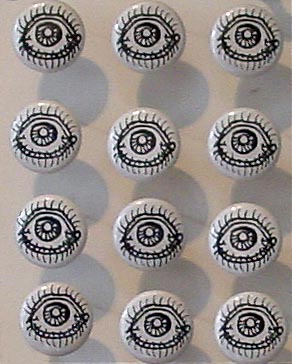
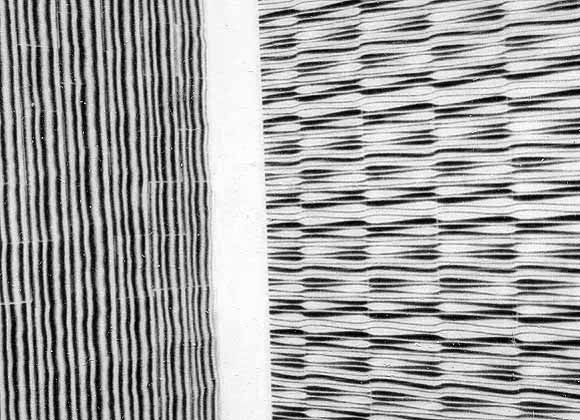
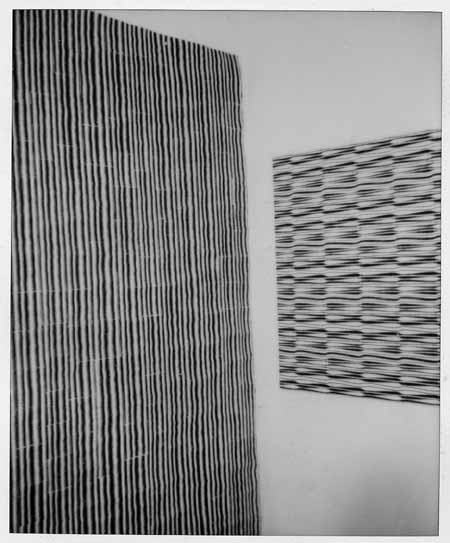
My 54th Street (Hell's Kitchen) studio, ca. 1998. Left hand image(s): Pipes 2, 1998, laser prints and linen tape, 88" X 78", previously exhibited here. The work on the right is untitled, same media. Each piece is essentially a giant paper quilt made of approx. three by five inch rectangles of xerox-printed paper taped together on the back (the linen tape is starchy and moistened when applied; when it dries it forms a "kite frame" of plaster-like strips that give the piece a sense of volume perceptible from the front). The big one hangs loosely on the wall, the small one is folded around a stretcher. Perhaps you can see where a group exhibition of black and white, repeating, Op art-like patterns, computer-made, with a kind of "jenky" outsider craft focus, would interest me. The "pipes" were originally intended to be cut out and used as struts or sticks for the molecules I was making, but I discovered that when placed side by side, they created intense, fairly painful optical vibration (not visible in these polaroid scans). These, and the allover patterns of spheres I was doing simultaneously, are what lead to my investigation and reworking of Op art rhetoric and ultimately my involvement in the "post-hypnotic" exhibition.
"p-h" traveled around the U.S. but never made it to NY. It would have been a hard sell here. I knew the idea of a (multiply-recontextualized) Op pseudo-revival was doomed when I read Roberta Smith's review of the Bridget Riley show at Dia. I'm paraphrasing here, but Smith basically said that Riley was tainted by her association with artists who would be forever on the margins, "especially in anti-Op New York." Wow, opposition to Op art is institutionalized here! Or was that another way of saying "anti-Op Roberta"? Considering the predominance of Op-like patterns in "The Infinite Fill Show," I guess it took the "teen bedroom angle" to override Roberta's dislike of the form and/or perception that it was discredited. Or, less cynically, maybe it was just the overwhelming evidence that artists find it more interesting than she does. [reposted from a few days ago with modifications.]
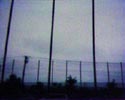 |
 |
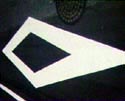 |
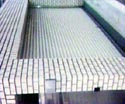 |
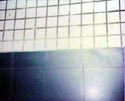 |
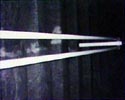 |
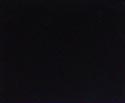 |
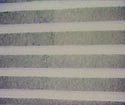 |
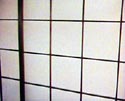 |
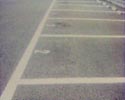 |
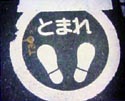 |
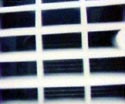 |
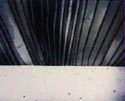 |
 |
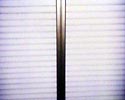 |
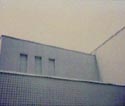 |
 |
 |
 |
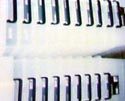 |
 |
 |
 |
 |
Aya T. Kanai, "Polaroids Tokyo/NYC," 2004, spectra polaroid photos, from "The Infinite Fill Show." Web layout (rephotography, slight cropping of installation views) by Tom Moody.
Still more thoughts on Infinite Fill. The so-called Bedroom shows Roberta Smith talks about in her review--she mentions Dearraindrop but Scott Hug's and Daniel Reich's shows also come to mind1--are mainly of sociological interest (collectives arise to challenge the hegemony of the individual genius, only to eventually be beaten down by the art world's need to market solo work--my cynical prediction), and backward-looking to the extent that they stand for some "rejuvenation of painting" discourse. The Providence collectives didn't invent the "colorful room full of manic cartoon imagery"--arguably that was Kenny Scharf's contribution to art...20 years ago. Whereas there is something larger at stake in IF, which is the merger of so-called new media art with traditional gallery exhibition practice. If art is to avoid shriveling into some finicky "cult of the hand," it's going to have to reconcile itself to technology, and eventually something interesting will emerge from what they used to call the "dialectic" between the two arenas. In Infinite Fill, the monochrome grid is the level playing field where the two opposed forces meet, intuitively connecting Sol LeWitt, needlepoint, and video games in an easy to read, "anyone can play" matrix. Also, as Sally McKay suggests in the comments to a previous post, "Infinite Fill" is a pun--it's about a computer filling up space and artists filling up a room with work. So far, none of the Bedroom Gang has come up with anything that elegant or concise, theory-wise.
1. I would exclude Paper Rad here, since their Foxy Production show was fairly tightly organized, with different walls devoted to different themes. I missed the Dearraindrop extravaganza at Deitch but friends said it wasn't so good--too much wall space to fill with manic creative activity. I did see their previous floor to ceiling effort at John Connelly, and like most people thought Billy Grant's video was the best part. You don't need a Soho barn for that, though--just a TV!
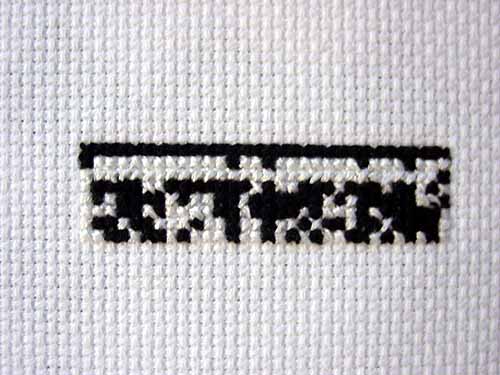
Cody Trepte, Why Are Numbers So Comfortable? (detail), cross stitch binary, 2004, from "The Infinite Fill Show".
Belatedly noticed that this image should be rotated 90 degrees counterclockwise. I don't know if it's the installation or my photo that got it wrong.
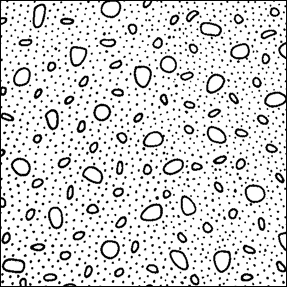
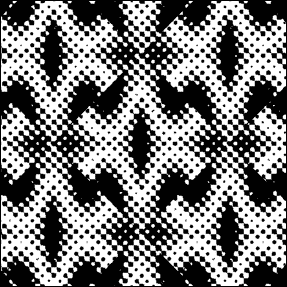
Before MacPaint incorporated black & white, so-called infinite fill patterns into home computer graphics, most already existed and were used by design firms, newspaper paste-up departments, and cartoonists for shading camera-ready art. Manufactured as adhesive sheets, they were (and still are by some) cut out with X-acto knives and mounted on illustration board. Zipatone was the company cartoonists swore by; it's now defunct but Letraset has a mind-boggling array of fill patterns viewable (and/or downloadable) online.
Transfer Graphics - Letratone (physical media - comes printed on sheets of adhesive film)
Dot TintsPhototone Imagery - Textures & Tones - Single Downloads
Geographical & Architectural
Dots & Grids
Mezzotints
Miscellaneous
There's been quite a bit of ruminating on various artblogs about "the role of criticism" recently, but the topic remains frustratingly vague since specific examples are avoided. As a case study--surprise, surprise--let's look at the critical reasoning behind the "Infinite Fill Show" (which we've been discussing here lately), as articulated in the exhibition materials and the New York Times review of the show.
Press release/call for entries theory: "The only rule is that [work submitted] has to somehow use black and white repeating patterns" (from the call for entries). "The curatorial concept was inspired by [MacPaint], the 1984 software application with varied 16-bit monochrome patterning that could be picked and dropped into areas of the screen to denote color and depth. For Cory and Jamie Arcangel, this rudimentary precursor to Photoshop's draw and paint functions provides a creative tool to explore multiple perspectives within a unifying aesthetic." (from the press release)
The "nostalgia factor" associated with old programs I addressed in an earlier post. Still worth considering are (a) how did pattern substitute for color and depth in MacPaint, exactly? are "bricks" a color? who came up with those patterns? how well did/do they work in actual practice? to what extent were artistic prerogatives usurped by engineering prerogatives? (b) MacPaint is a precursor to Photoshop, which is pixel-based, but how does it relate to vector programs such as Illustrator, which use defined curves rather than rectangular blocks? If the show is a form of ancestor-worship, whose family is being feted? are pixel-based programs more "important" because they've been subsumed into html and web design? (c) to what extent was MacPaint old news, incorporating pre-1984 print conventions such as Ben Day dot patterns (also frequently alluded to in "Infinite Fill"), zipatone, or letratone?
New York Times theory (i.e., everything but the purely descriptive parts of the review): (1) "How many different ways can a work of art combine black, white and repetition? An answer is essayed by 'The Infinite Fill Group Show...'" (2) "The show is intended as a homage to [MacPaint], an early computer application (released in 1984) that enabled the user to click and drag a range of black-and-white patterns into images of any kind." (3) "[T]he show resembles a photo-negative of the floor-to-ceiling, color-saturated conventions of the so-called 'bedroom shows,' those showcases for collaboratively minded young artists that reached an apotheosis of sorts in Dearraindrop's extravaganza at Deitch Projects in SoHo..."
The "youth culture" and "psychedelia/color saturation" issues were raised here earlier. Perhaps "Infinite Fill" was also a "photo-negative" (inversion) of the teenager's bedroom shows because if included artists of all ages? What was the kid-to-geezer ratio? Does it matter? Item (1) slightly restates the show's premise (as a way of saying how diverse it is): but did each work in the show in fact use B&W and repetition? (No.) Black & white schemes are sometimes used by curators (not naming any names) to unify group shows of quite disparate work but disguise the lack of a thesis. Is that the case here? (No!--but why?) Does the fact that MacPaint was monochrome and used fill patterns justify the inclusion of works such as needlepoints, enlarged newsprint images, and zebra rugs? How is the political work in the show justified by a formal premise? Is the premise "merely formal"? The Times doesn't answer these questions with specitic examples (and neither have I in this short post); unless or until someone does so, a gap between theory and description remains unfilled.
Returning to the point raised in my first sentence, I submit that the "role of the critic" is to answer questions and plug gaps such as the above. (Not holding my breath, though.) As long as there is work to be done you don't sit around bemoaning what you're supposed to do.
UPDATE: This post has been reworked a bit to take into account the wording of the Arcangels' call for entries. I also added the links about historic fill patterns (zipatone, letratone).
The "Infinite Fill Show" gets the lead review in the New York Times today (page E32 of the print edition). Critic Roberta Smith says the exhibit, with its all-black and white color scheme, resembles a "photo-negative of the so-called 'bedroom shows,' those [floor-to-ceiling, color saturated] showcases for collaboratively minded young artists that reached an apotheosis of sorts in Dearraindrop's extravaganza at Deitch Projects..." After that, the review is pretty descriptive; she concludes by noting the show is an homage to "Mac Paint (sic)." It's a glowing write-up (for this non-effusive critic), and congratulations all around, but Smith really ought to read blogs more. If she did, she'd know that Jamie Arcangel is female. Pretty funny--she describes "Infinite Fill"'s organizers as "the artists and brothers Cory and Jamie Arcangel."
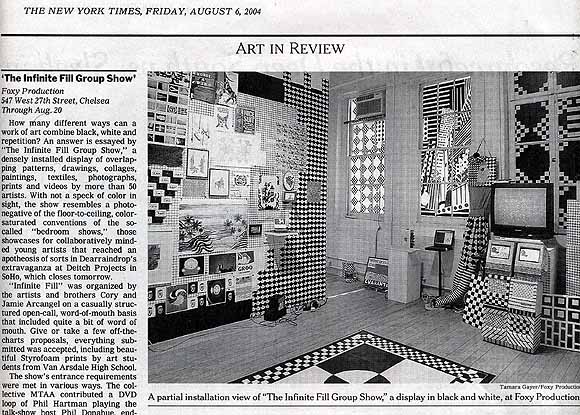
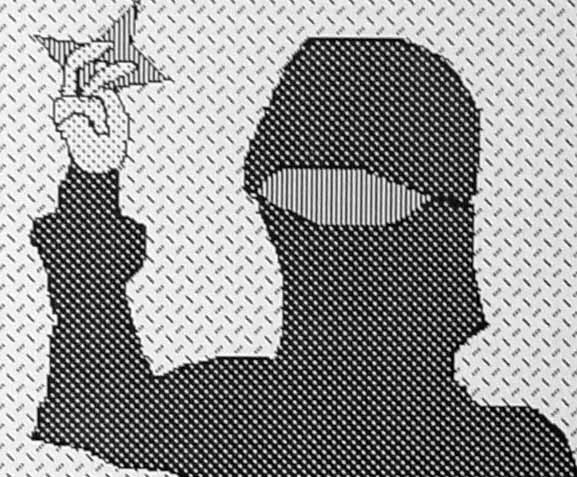
More work from the "Infinite Fill Show." Above: Kevin McGarry, NIN.gif (detail). In the lower part of this image, not shown here, the ninja is carrying a scythe like the Grim Reaper--is this some game character I don't know about?
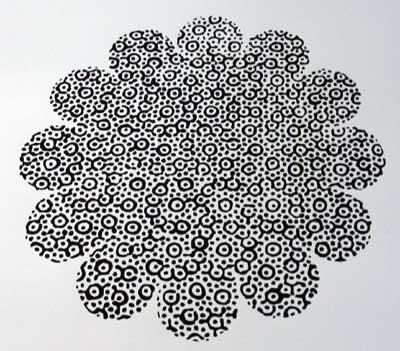
Louisa Minkin, Blindspot (detail of watercolor).
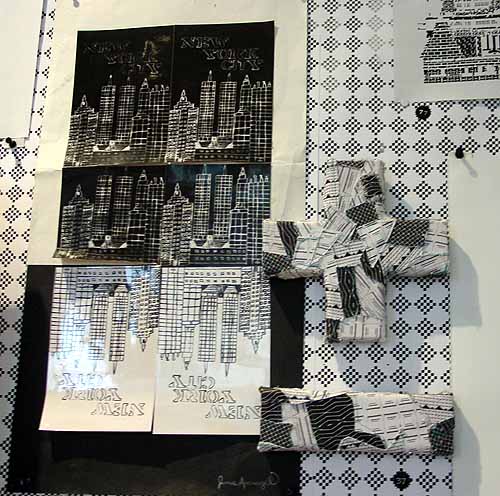
Jamie Arcangel did the New York City collage (in high school) and LoVid the patchwork plus and minus.
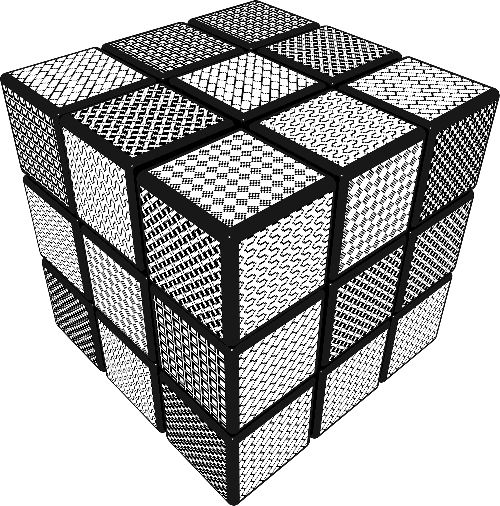
Jim Hamlyn, original .GIF, printed out for the "Infinite Fill Show." This image has been resized, the full image is here.
More about the show: Walter Robinson mistakenly describes the content in his Weekend Update column as "psychedelia and goth." Maybe he pasted in a paragraph from an old Whitney Biennial 2004 review by mistake? You have to stretch to find anything goth in the show, and psychedelia kind of implies color to most people these days, doesn't it? The keywords here are "Op Art" and "geek." Also, it's hard for me to imagine the phrase "eternal youth culture" coming out of the Foxy Production gallerists' mouth: who talks about shows that way? Besides, it's redundant, as I've argued on this page repeatedly: all of American culture is "eternal youth culture."
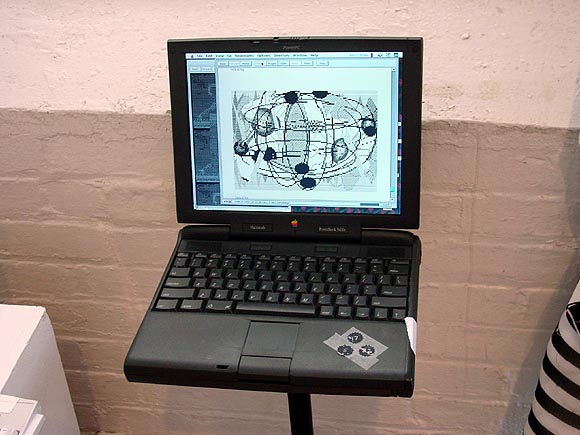
"Infinite Fill Show" installation view of collaboration: jimpunk (www.jimpunk.com) vs. tom moody, 2004, running on Netscape (slower than here, but it's fine that way, too). The gallery listed my and jimpunk's animated .GIFs as "URLs, not for sale" because I was too big a dork to burn them on a CD and demand several hundred thousand bucks for them. The small circles taped on the powerbook are checklist numbers.
Looks like there's going to be some national press for the show; I plan to keep posting about it, with more pictures coming, etc. This will be diary-style reportage, not criticism per se, since I'm obviously not detached.
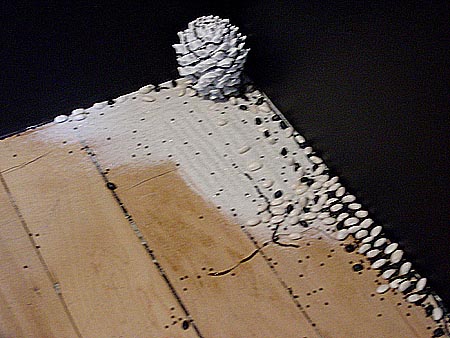
I went back to look at the "Infinite Fill Show" today and took some more pictures; I'll be putting them up gradually. This one came out blurry and I feel in all good conscience I should reshoot it, but I'm posting it anyway. It's an installation by Leif Ritchey, very easy to overlook down at your feet, in a corner. Yes, it's a zen rock garden with a black and white pine cone, beans, and raked sand, an elegant (but still somewhat lowbrow) counterpoint to all the digital brut up at eye-level. Ritchey's an analog guy, and I've been playing his video "Flatbush Windows" over and over and showing it to friends. I found it on the Nautical Almanac-related compilation Eyes of the Mind (which I've been meaning to write about--it's awesome). The video is as understated as this piece--grainy bits of one-step-removed footage shot off an awkwardly framed TV screen, depicting trees blowing in the wind, people walking up and down the sidewalk, clunky jump cuts of a pair of women's shoes (decorated with beads? I have to watch it again), with a soundtrack of jazz and quiet techno that's somewhat tinny, like it's wafting in from another room. The best kind of Cagean work, strangely gripping for being so ephemeral.
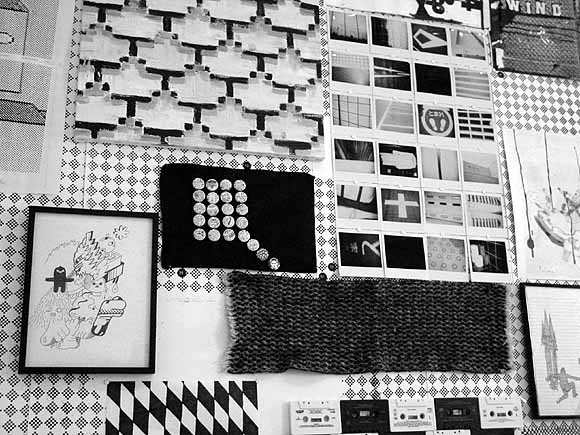
"The Infinite Fill Show" installation photos - thumbnails.
Press release (incl. artist list).
Critical pontification / more/ still more.
New York Times review (text) / (scan)
Time Out NY review
The exhibition opening was crowded but not too crowded and hot but not too hot. The work fell into two broad categories: things made with actual digital fill patterns (printouts, videos) and hand-crafted objects that mimicked fill patterns (paintings, drawings, needlepoints). Variations and exceptions abounded in this 90-some artist show. A nice touch was the silkscreen-printed dot matrix check pattern tacked up as background wallpaper--that (and the black and white color scheme) helped to unify everything. Overall, an amusing mix of lumpen craft and tech, politics and non-politics, the timeless and the topical (e.g., a tabloid cover of Martha in prison stripes). Paper Rad played a song in the hall and blew a fuse, which killed the gallery overhead lights but not the plugged-in laptops, TVs, or the strobe light. Enough daylight still came in to see the show. Kudos to Cory and Jamie Arcangel for packing the small gallery with nice stuff to look at.
UPDATE: More photos, showing the stunned and bemused opening night crowd (as opposed to my more severe photographic "statement") are at James Wagner's site.
WHY INFINITE FILL? WHY NOW? (SOME THEORIES)
Speaking of Infinite Fill patterns, an artist saw the image of mine below printed out in the studio and said something like "It's so old it's new again." That's actually kind of a bad reason to be working with these patterns and programs: what might be called the fleeting buzz of historicization. Two generational moments connected with an emerging technology are when you experience it in all its newness (especially in pimply adolescence), and when you encounter it nostalgically as a kind of "future past." The rubbing together of those two instants can throw off some sparks, but they're pretty meager to power a body of work, or a career. Better reasons for using old programs might be: (1) to access good effects that have been superseded or "improved" in newer programs, (2) as a way of clearly revealing the futuristic assumptions, mass production values, or plain bad aesthetics of existing programs (most of which are just tricked-up, bloated versions of the old ones), and (3) because less is more, as Kate Moss once said.
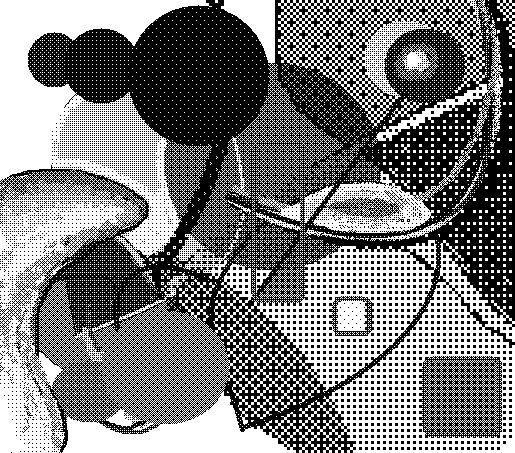
Below is the press release for the "Infinite Fill Show," opening Thurs., July 22 at Foxy Production in New York. The call for entries describing the project is here. I submitted three animated .GIFs, which I'm told will be shown on a laptop. The .GIFs themselves (including two of mine & a collaboration with jimpunk) are here; the html display page


Curated by Cory + Jamie Arcangel
Opening reception: Thursday, July 22, 6.00 - 8.30 pm
Dates: July 22 to August 19, 2004
Summer hours: Tuesday to Friday, 11.00 am - 6.00 pm
Foxy Production (547 WEST 27 ST. FL 6, NYC 10001 - TEL 212 239 2758) announces The Infinite Fill Show, a group exhibition of dazzling black and white patterns, curated by brother and sister team Cory and Jamie Arcangel. The exhibition includes new and historical, readymade and handcrafted works in a range of media.
The curators sent out an open call to artists for found or made objects which had to adhere to two basic rules: they must be black and white, and they must contain repeating patterns. The curatorial concept was inspired by MAC Paint, the 1984 software application with varied 16-bit monochrome patterning that could be picked and dropped into areas of the screen to denote color and depth. For Cory and Jamie Arcangel, this rudimentary precursor to Photoshop's draw and paint functions provides a creative tool to explore multiple perspectives within a unifying aesthetic.
The Infinite Fill Show, features over fifty artists, from high school students to internationally renowned artists, including: Lucas Ajemian + LLFS, Elyse Allen, Cory Arcangel, Jamie Arcangel, Maureen Arcangel, Steve Austin, Jimmy Baker + Matt Coors, Michael Bell-Smith, Marc LeBlanc, Orit Ben-Shitrit, Chris Bors, Sascha Braunig, Jonah Brucker-Cohen, James Buckhouse, Anthony Campuzano, Henry Chamberlain, Peter Coffin, Ryan Compton, Elisabeth Condon, Devon Costello, Jim Drain, Sarah Dunbar, Dragan Espenschied (with Sofia Aleinikova), Devin Flynn, Nello Gacuda, Joy Garnett, Tamara Gayer, Paul Gigolotti, Benjamin Godsill, Katherine Grayson, Sabrina Gschwandtner, Jim Hamlyn, Tamara Henderson (with Brent Wadden), Honeygun Labs, G.H. Hovagimyan, Akiko Ichikawa, Ketta Ioannidou, jimpunk + Tom Moody, Aya T. Kanai, Chris Kasper, Ori Kleiner, Paul Laster, LoVid, Noah Lyon, Kevin McGarry, Joe McKay, Erica Magrey, Frankie Martin, Jonte Martin, Jillian Mcdonald, Louisa Minkin, Justin Mitchell, Kyle Mock, Mombert, Tom Moody, MTAA, Josh Nimoy, David Noonan, Marisa Olsen, PAPER RAD, Marcin Ramocki, Scott Reeder, Tyson Reeder, Douglas Repetto, Leif Ritchey, RSG, Sterling Ruby, Justin Samson, Gregory J Scranton, Daniel Shiffman, Sistaz 4Ever, Paul Slocum, Renee So, Erika Somogyi, Nancy Smith, Oriane Stender, Kirsten Stoltmann, Jennifer Sullivan, Joshua W.F. Thomson, Cody Trepte, Van Arsdale High School Art Students, Andrew M.K. Warren, Ben Warwas, Andrew Jeffrey Wright.
UPDATES: A short report on the opening (with installation photos) is here (also links to other posts, criticism, etc.) The artist list above has been edited to conform to the exhibition checklist.
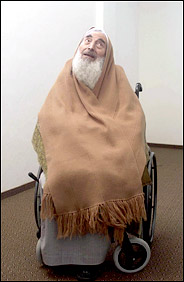
Speaking of the Middle East and Star Trek, the picture above of the late, soon-to-be-blown-away Sheik Yassin (from the New York Times, looking much like a waxwork from Madame Tussaud's) made me think of Captain Pike:

Which reminded me to look for a cybertheory essay I read years ago, by Alan Shapiro, called "Captain Kirk Was Never the Original." Lo and behold, I found it, and commend it to your reading. In a nutshell, Shapiro contrasts Kirk's Cartesian man of action with Pike's traveler in virtual reality, suggesting that we "read Star Trek against Star Trek" rather than dismiss it, as many theorists do, as a relic of pre-digital consciousness. Here's a good excerpt:
The successful media product model has as prerequisite a mythical moment of transcendent creativity which clears the way for the emergence of a new spectacle object. The spectacle object (celebrity, consumer gadget, media property) then enters the panoply of fetishes among which we shop in our efforts to find an identity "niche" and dubiously distinguish ourselves from others. The model serves as lightning rod for ambivalent collective projections, allowing each individual to feel unique at the very moment when all consumers of that same niche are imitating the same elevated pattern.And another cool passage:
But the fully achieved simulacra of virtual reality threaten the stability and profitability of this system of differences. This is why Captain Pike, who was too far ahead of his time, had to be shunted aside in favor of the valorous Captain Kirk.
So Pike, the true first-born, was whisked away into virtual reality and replaced by the changeling Kirk. There was, of course, another way forward for Captain Pike, but the screenwriters of "The Menagerie" were unfortunately ignorant of the basics of writing operating systems software drivers for peripheral devices. Since Pike's bio-rehabilitation programmers had succeeded in resuscitating at least one controllable nerve impulse from his consciousness, and connecting the discrete signals of this impulse across the synaptic gap to an output device (the beeping for "yes" or "no"), further layers of software to drive more sophisticated output devices and sound cards would certainly be possible. From the single binary registering of a 0 or a 1, an entire operational language (a full digital communication) can be devised. One merely has to enumerate and combine varied sequences of 0s and 1s as discrete identifiers in an infinitely permutated system. The only drawback would be that Pike's consciousness itself would always remain at the level of the lowest machine language, forced to perpetually master and will the lengthy binary sequences in order to express himself! He would literally be the machine and its finally awakened artificial intelligence.
The critical consensus about Mel Gibson's hugely popular Jesus movie (over $200 million in box office and it's only the second weekend) is that it's a sustained exercise in audiovisual pain: why just lower the crown of thorns onto Christ's head when you could pound it into his scalp with a hammer? There's a centuries old tradition of depicting this kind of suffering, especially in painting and sculpture, which frankly I'd rather read about than see reenacted in Dolby Surround with the latest special effects technology. Alex Wilson discusses the "Man of Sorrows" tradition of devotional images here, particularly those of Albrecht Durer, who did what you know Mel wanted to do and probably would have done if he'd been Rich Mel rather than Mad Max 20 years ago: cast himself as Jesus. ionarts has some additional, interesting historical detail on another famous Man of Sorrows, the one in Matthias Grünewald's Isenheim Altarpiece, discussed here earlier. I first learned about the latter work reading J.-K. Huysmans' grueling description from his occult novel Là-Bas. This is art criticism at its most committed and unstinting; Mel's got nothing on this account.
"Purulence was at hand. The fluvial wound in the side dripped thickly, inundating the thigh with blood that was like congealing mulberry juice. Milky pus, which yet was somewhat reddish, something like the colour of grey Moselle, oozed from the chest and ran down over the abdomen and the loin cloth. The knees had been forced together and the rotulae touched, but the lower legs were held wide apart, though the feet were placed one on top of the other. These, beginning to putrefy, were turning green beneath a river of blood. Spongy and blistered, they were horrible, the flesh tumefied, swollen over the head of the spike, and the gripping toes, with the horny blue nails, contradicted the imploring gesture of the hands, turning that benediction into a curse; and as the hands pointed heavenward, so the feet seemed to cling to earth, to that ochre ground, ferruginous like the purple soil of Thuringia.
"Above this eruptive cadaver, the head, tumultuous, enormous, encircled by a disordered crown of thorns, hung down lifeless. One lacklustre eye half opened as a shudder of terror or of sorrow traversed the expiring figure. The face was furrowed, the brow seamed, the cheeks blanched; all the drooping features wept, while the mouth, unnerved, its under jaw racked by tetanic contractions, laughed atrociously.
"The torture had been terrific, and the agony had frightened the mocking executioners into flight.
A friend of mine was kidding me for saying I liked Dragonball Z, a much serialized, much butchered anime series that runs infinitely on the Cartoon Network on cable. I was trying to think what possible justification I had. Then I remembered King Kai. He's a sort of Yoda character that teaches battle tactics. He lives on a tiny planet in another dimension, which you get to by traversing Snake Way, which looks like the Great Wall of China on the back of a snake hundreds of miles long, twisting through the clouds. See the three people standing on the grass in the center of the planet? Each weighs 700 pounds in its enormous gravity. That's why it's such a good training place: if you can move at all you get stronger. Kai himself has blue skin, catfish whiskers, cockroach antennae, and dresses in priestly garb--with little hipster shades. He talks like a cross between Sylvester the Cat and Elmer Fudd, and constantly tells terrible jokes, like "You can tune a piano but you can't tune a fish." He's just the greatest!--and reason enough in my book to tune into the series. He's the type of "what the hell were they thinking?" character that pops up only in anime.
On Wednesday, Nov 20, I attended a panel discussion on "Painting in the Age of Digital Manipulation" at Artists' Space in NYC. Mark Tribe, director of the new media website rhizome.org, moderated, and each of the four panelists, Claire Corey (image below), Millree Hughes, Sherry Mayo, and Fabian Marcaccio, showed slides and fielded questions. The panel was a clash of cultures, to some extent, since rhizome.org exists within an infrastructure of funding and exhibition spaces largely distinct from the "gallery world" that the four panelists inhabit. Tribe's opening remarks contained an intriguing word choice. He described the panelists as painters using digital tools, as opposed to technologists making paintings. This immediately made me wonder "Who would be in the latter category?"
I'll go ahead and answer my own question and say that John Maeda and Golan Levin, programmer/artists from the MIT Media Lab environment, immediately spring to mind as "technologists making paintings." Their inclusion might have made the panel more meaningful, but it was frankly more enjoyable looking at work by technological autodidacts who really know how to push (virtual) paint around. Interestingly, although all four panelists are concerned with output, printing their work on canvas or other materials for ultimate display in galleries and museums, they all used multimedia tools--CD, DVD, digital animation--to show it to the audience. During these presentations, their work was indistinguishable from much new media art. One's respect for Corey's and Hughes' work really deepened when you saw animations of their work-in-process. Corey's DVD took viewers through 25 stages in the development of one of her paintings, and it was amazing how radically the piece changed from one stage to the next. Hughes, who uses Flash as his primary paint program, showed an interactive game where an unseen button pusher makes random combinations of colors, sizes, and spatial orientations; Hughes works the "byproducts" of the game into his creative process.
Hughes also read an eloquent prepared statement, in which he discussed the activities of the digital painter in the context of the "contingent reality" of the Internet, where every opinion is given weight and facts are hard to separate from hearsay. He distinguished the digital painter's choices in making art from the consumer's choices online (the former being infinite and problematized; the latter being determined largely by checking boxes in multiple choice forms). Sherry Mayo made a similar point later when she analogized computer art to early video art, which subverted the conventions of commercial TV by making the tapes longer than most people's attention spans, through odd cropping strategies, and so forth.
After the four articulate presentations, I felt like groaning when someone in the audience asked the (predominantly abstract) artists on the panel, "Can each of you say how you're addressing the issue of content of your work?" Beneath this question lies a very tired, conservative accusation: that pictures of people, places and things have content and abstract art does not. All the artists patiently
(re-)answered the question, even though they'd been discussing content for the previous hour. Tribe also raised a rather old-fashioned issue, half-apologetically (considering his stake in new media), when he asked (of all but Marcaccio): "Do any of you miss pushing actual paint around?" The consensus was that the artists didn't. Tribe also asked if the four artists felt they were the vanguard--if they felt more historically important--being the first to use a new medium. No one was trapped in that kind of pomposity, but of course they are more courageous and enterprising to move into an area that has minimal collector support.
People sitting in a darkened theater stare at a large reflective surface, while cell phones ring randomly throughout the room. The typical moviegoing experience at Times Square? No, it's a musical piece called Dialtones, which I recently learned about on dratfink's page. This "telesymphony," performed in connection with the Ars Electronica festival and funded by Swisscom Mobile, etc, is a half-good idea that just doesn't know when to quit. Check out the exhausting spec sheet: the piece is a social sculpture, it uses corporate switching systems as a found medium, it employs a lot of clever programming and hardware, it's electronic music, it's live performance, it's an audience participation piece, it has flashing lights, it has graphics, it has Mylar!
This kind of MIT Media Lab product (at least one of the performers went there) just pounds you with technology. It's essentially a loss leader for the tech industry, crafted by geeks whose art sense derives from rock concert multimedia shows. Audience members are asked to register their phone numbers when they arrive for the concert, special ringtones are downloaded to their cells, and then a musical ensemble "plays" the phones in an auditorium by punching buttons on a graphic display. So far, so good, I guess, but do we really need spotlights hitting the audience members when their cells ring? Keychain lights distributed to everyone that glow red two seconds before the tones go off? To see all this activity in a reflective mirror? The visual element is as gimcrack-filled as a Spielberg movie.
The piece assumes an audience with near-infinite time, patience, and trust. You have to be willing to queue for a seat assignment, surrender your private number (to whom exactly?), and accept the downloaded "custom ringtone," all for the sake of one concert (to remove the tone, you're presumably on your own). Thirty minutes of antiphonal chirps, climaxing in the inevitable "crescendo of sound," might be pretty interesting to sit and listen to in the dark, if you weren't also being forced to "participate." The authors dispense grant-panel-friendly nonsense when they say this participation is "active," though. Your creative input consists solely of choosing a ringtone (doesn't the phone company also call this "creativity"?) and deciding what exotic handwaving motion to make when the spotlight hits you. The spec sheet doesn't mention another option you have that would definitely affect the "texture" of the piece: turning off your phone.
Two years ago this fall, video artist Caspar Stracke did a performance at PS1 with an obsolete consumer video player called a CED: basically he just let the glitch-ridden machine run for six hours. The CED player (exhaustively documented on this website) was the biggest loser at a time (the early '80s) when VHS, Beta, and laser discs were all competing for market share. It works like a vinyl record player: you slide a twelve-inch-square cassette into a long slot, the disc drops down into the machine, and a tone-arm reads the capacitance (analog information) stored on grooves on the disc. Stracke has several malfunctioning machines, and each reads the discs in its own uniquely screwed-up way. Unfortunately I missed the performance, but the amazing press release caught my attention, so I looked up Stracke and visited his studio. He showed me a couple of CEDs, projected large on the wall, and the "errors" do make for fascinating viewing. As he explains in the press release: "the machine, 17 years old, reads scratches on the disc not like crackles on an audio record but chops a scene into fragments less than 1/4 second long and reassembles them by chance operation. The needle gets physically irritated by several factors besides the scratches that let it skip the grooves, resulting in an infinite number of similar but not identical collage variations of the same scene. The performed 'cuts' are almost seamless."
Thus, in the CED of The Shining, you see Danny playing darts by himself in the kitchen of the Overlook hotel; he stands up on a chair to retrieve a dart, turns around, and sees the spooky twin girls. Then he's instantly back on the floor, on the chair again, on the floor, on the chair, and sees the girls again. Then he's on the chair, grabbing a dart, and suddenly he's teleported ahead to a completely different scene in the movie, then he's back on the chair, but always, in the about eight different loops I saw, the "scene" ends with him seeing the girls. It's like a bad dream that keeps repeating itself, or the chapter in Philip K. Dick's Martian Time Slip where the same events are refracted through Manfred's autistic consciousness over and over, each time slightly different but all ending dismally. The looped events don't have to be negative, of course: in a busted CED of Douglas Trumbull's Brainstorm (1983), Natalie Wood and Christopher Walken have a screen kiss that keeps getting interrupted by the skipping player, so that an erotic moment is deliriously sustained. That's especially ironic, since the subject of Brainstorm is a new virtual reality technology (also analog) that allows people to record, playback, and loop experiences and share them electronically with others: happy memories, orgasms, after-death experiences, stuff like that.

